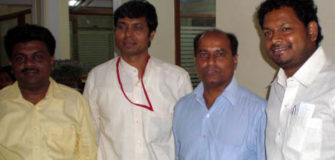Share
Reconstructing Indian Hockey
by K.P. Narayana Kumar, N.S. Ramnath
Michael Nobbs is rebuilding Indian hockey. But first, he had to destroy it
In the future, sports historians will mark February 26, 2012, as the day Indians rediscovered their national sport.
On that day, at the National Stadium, Delhi, the crowd was delirious, jumping, screaming for Sandeep and Sardara, Bharat and Sunil, as if they were Tendulkar or Dhoni. With every goal India scored against France, the excitement rose another notch. When the game ended, and India had qualified for the Olympics, the crowd was in sporting nirvana. A placard captured the mood: Cricket: Zero/Hockey: Hero.
The media joined in, albeit in lower key. The Times of India’s front page said ‘Gr8 show’ (India scored eight goals in the finals). The Asian Age was as exuberant: ‘London, here we come.’ The Hindu, more sedate, said, ‘India’s Olympic dream rekindled.’
Related stories
All this for hockey? For a sport whose glories people only talked of in the past tense, in the wistful tone they used when they referred to trams and cabinet-sized valve radios? Sure, Indian hockey was the stuff of legend. Hockey historian K Arumugham says that in 1928, when the Indian team was on its way to Amsterdam, they played a series of exhibition matches in England. Seeing its calibre, England decided not to field a team for the Olympics as “they did not want to lose to a slave country”. Between 1928 and 1956, India won six Olympic gold medals in a row, followed by a silver in ’60 and gold again in ’64. As the world caught up, India could only manage bronze in ’68 and ’72, and, aided by a big Western boycott, an eighth gold in the 1980 Moscow Olympics. Since then, the team hasn’t got near the podium.
Economists are familiar with the phenomenon. Companies that once revolutionised and dominated new industries—Xerox in copiers or Polaroid in instant photography—saw dominance vanish and profits fall as rivals launched improved designs or cut manufacturing costs. Technology advances too, making one-time giants obsolete: Wax cylinders gave way to records, which ceded ground to spool decks, which then were replaced by smaller cassette tapes, which were in their turn replaced by compact discs, which lost out to MP3 players, which are now losing out to do-everything phones.
Clayton Christensen, a leading management thinker, studied over a 1,000 companies across 15 industries, and concluded that even the best-run and most widely admired of them were unable to sustain market-beating levels of performance for more than 10-15 years.
Is decline inevitable? Over the last century, there has been consensus on the solution. But the prescription is a difficult one. In the 1940s, Joseph Schumpeter, an Austrian economist, gave it a name: Creative destruction. Old processes, old ways of thinking, old industries—they must make way for the new.
The crowd at the National Stadium saw a team with newfound confidence. What they didn’t know was that they were witnessing the results of a creative destruction exercise. And that the man responsible was a soft-spoken, laid-back Australian, Michael Nobbs.
Nobbs is 58, six feet tall. He never seems to be in a hurry, but when you walk with him, you realise that’s just plain deceptive. He makes the simple act of sitting in a chair seem like he’s collapsing into a hammock. He almost never raises his voice, his smile rarely leaves his face. Not exactly your hard-bitten, bellowing, alpha male Hollywood stereotype.
He assumed charge of the Indian team at a particularly tough time: The memory of not having qualified for the Beijing Olympics was still fresh. Add a power struggle between Hockey India and the Indian Hockey Federation for control of the sport in the country. And a team trying to adapt to the European style, which emphasised defence; they seemed to be getting the hang of it, but in tournaments, they were mostly getting trounced.
To Nobbs, this was bizarre. He had grown up admiring Indian hockey’s aggression, its flair and flow. He’d first seen it as a boy, watching Anglo-Indian immigrants play, and he still remembers watching India play Pakistan: “It was pure magic!”
The deficiency, as he saw it, was not in skill but in fitness. You just have to place an average Indian player next to an average European or Australian player to see this. Fix that problem, and India can rule the astroturf. He wasn’t the first to have that insight. But, as every businessperson knows, insight is nothing without execution. And that is where the Nobbs story really begins—and ours.


